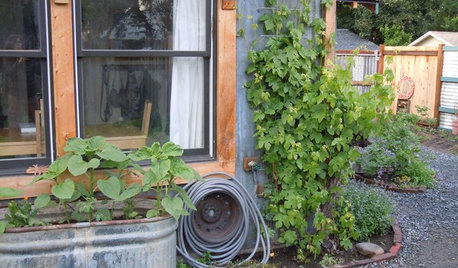Large triangular brown tips on leaves of Zebra Plant
chicalouise1
11 years ago
Related Stories

GARDENING GUIDESWhat's Wrong With My Plant? Leaves Often Hold the Clues
Learn how to identify common plant ailments by reading their leaves
Full Story
REMODELING GUIDESYour Floors: Zebra, Tiger, and Teak Wood, Oh, My!
Get the Pros and Cons of Exotic Woods: Hickory, Cherry, Rosewood and More
Full Story
DECORATING GUIDES5 Decorating Tips for Getting Scale Right
Know how to work art, sectionals, coffee tables, lamps and headboards for a positively perfect interior
Full Story
GARDENING GUIDESEdible Gardening Essentials: Tips for Traditional Hand Watering
Save the expense and hassle of a complicated garden system with a simple watering can or inexpensive hose add-ons
Full Story
FARM YOUR YARDHow to Grow Vegetables in Containers
Get glorious vegetables and fruits on your patio with a pro’s guidance — including his personal recipe for potting mix
Full Story
DECORATING GUIDES13 Strategies for Making a Large Room Feel Comfortable
Bigger spaces come with their own layout and decorating challenges. These ideas can help
Full Story
HOLIDAYSChristmas Cleanup Tips for the Not Naturally Organized
Dreading the postholiday chores? First let yourself unwind. Then grab some boxes, a few supplies and this easy guide
Full Story
ORGANIZINGProfessional Tips for Organizing Your Clothes Closet
As summer draws to a close, get expert advice on editing and organizing your wardrobe
Full Story
BEDROOMS7 Tips for Designing Your Bedroom
Learn how to think about light, layout, circulation and views to get the bedroom of your dreams
Full Story
EXTERIORS5 Easy Tips for Choosing Your Exterior Paint Palette
Make your home the talk of the neighborhood — in a good way — with an exterior paint scheme that pops
Full Story









greenlarry
rhizo_1 (North AL) zone 7
Related Professionals
Allen Landscape Architects & Landscape Designers · Carson Landscape Architects & Landscape Designers · Finneytown Landscape Architects & Landscape Designers · White Oak Landscape Architects & Landscape Designers · Lakeland Landscape Contractors · Stoughton Landscape Contractors · Emmaus Landscape Contractors · Golden Landscape Contractors · Middletown Landscape Contractors · Newnan Landscape Contractors · Parkland Landscape Contractors · Rochester Landscape Contractors · Snoqualmie Landscape Contractors · Wallingford Landscape Contractors · West Chester Landscape Contractorsgreenlarry
The Ficus Wrangler
Polly381
greenlarry
tapla (mid-Michigan, USDA z5b-6a)